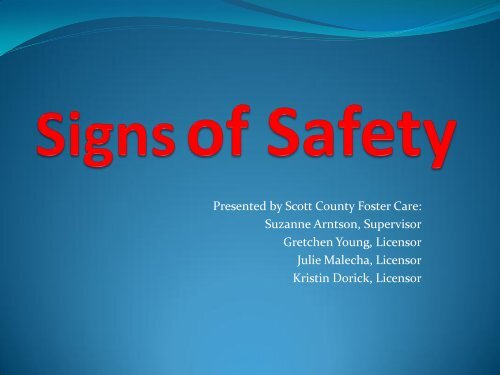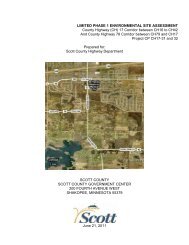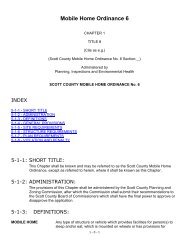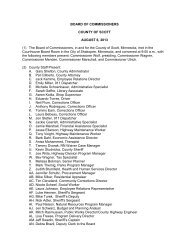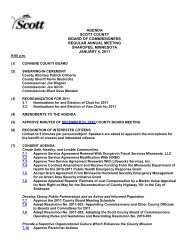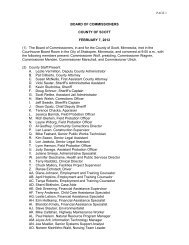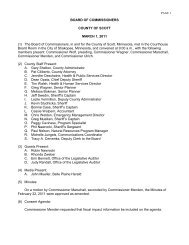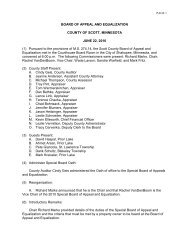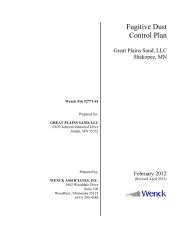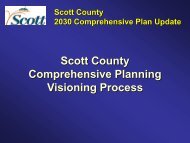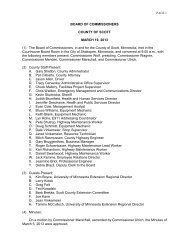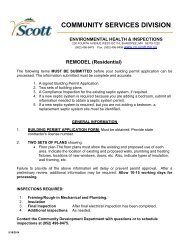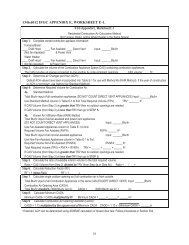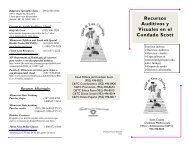Signs of Safety Overview PowerPoint - Scott County
Signs of Safety Overview PowerPoint - Scott County
Signs of Safety Overview PowerPoint - Scott County
- No tags were found...
Create successful ePaper yourself
Turn your PDF publications into a flip-book with our unique Google optimized e-Paper software.
<strong>Signs</strong> <strong>of</strong> <strong>Safety</strong> Around the World• Who is using the <strong>Signs</strong> <strong>of</strong> <strong>Safety</strong> framework?*Japan*Canada*United Kingdom*Sweden*Finland*New Zealand*The Netherlands*Australia
<strong>Signs</strong> <strong>of</strong> <strong>Safety</strong> in Minnesota• Olmsted <strong>County</strong>• Led the movement. Started their work in the early 1990’s• Carver <strong>County</strong>• Worked with Andrew Turnell over the past 5 years.• <strong>Scott</strong> <strong>County</strong>• Over the past 1 ½ years• Other counties at using the framework include:• Wright• Anoka• Hennepin• Stearns• St. Louis*there are many other counties that are in the early states <strong>of</strong> learning andimplementing this framework.
<strong>Signs</strong> <strong>of</strong> <strong>Safety</strong>3 Key Questions1. What are we worried about?(Harm and Danger statements)2. What is going well?(Search for strengths, best hopes)3. What needs to happen?(Next steps, safety plan)
<strong>Signs</strong> <strong>of</strong> <strong>Safety</strong> Framework4 Key ElementsI. Focus is on child safetyII. Partnership with ParentsIII. Identifying strengths that lead to safety(A list <strong>of</strong> services do not keep kids safe)IV. <strong>Safety</strong> planning and development <strong>of</strong> <strong>Safety</strong>Networks(“It takes a village to raise a child”)
Element I: Focus on Child <strong>Safety</strong>What does safety mean?• <strong>Safety</strong> is defined as strengths demonstrated as protection over time.Clearly identifying and defining harm and danger:Harm Statement - 2 components:• What has happened to the child, and• The impact it had on the childDanger Statement -2 key issues:• Needs to capture the seriousness <strong>of</strong> the issue (i.e. what are weworried about)• Needs to be something a safety network can sign <strong>of</strong>f on and be investedin*Danger statements must be simple so the youngest person in the familycan understand and in the family’s language as it serves as theframework for effective safety planning.
Element II: Building PartnershipsWhat does research tell us about the importance <strong>of</strong> buildingrelationships? It says:The best predictor <strong>of</strong> positive outcomes forchildren in child protection cases isrelationships.• Relationship between the worker and otherpr<strong>of</strong>essionals (foster parents, therapists, etc) and thefamily.• Relationships between pr<strong>of</strong>essionals.• Child safety is compromised when the variouspr<strong>of</strong>essionals are not “on the same page”
• Adobe Systems Incorporated 99• Apple AppStore 99• NBA 99• American Express 99• Wikileaks 99• OneLouder Apps 99• WWE 99• Fox News 98• Wired 97• H&M 97• CNN 97• Louis Vuitton 96• Instagram 95• Amazon 95• NASA 95• Starbucks 95• TwitPic 95• Target 95• Subway 94• TweetDeck 94• BBC World News 93• The New Yorker 93• National Geographic 93• Digg 92• NPR News 92100 Most FollowedBrand’s Klout Scores• 26. Whole Foods Market 92• 27. Snaptu 92• 28. InStylecom 91• 29. Good Morning America 91• 30. Chanel 90• 31. TMZ 90• 32. WWD - Women's Wear Daily 90• 33. Hootsuite 90• 34. Life.com 90• 35. JetBlue Airways 89• 36. Christian Dior 89• 37. Neiman Marcus 89• 38. Pitchfork 89• 39. Chelsea Football Club 89• 40. Net-a-porter.com 89• 41. Oreo 88• 42. BBC Breaking News 88• 43. Guardian Technology 88• 44. Reuters 88• 45. Funny Facts 88• 46. Woot 87• 47. Nike 87• 48. Nimbuzz 87• 49. Disney 87• 50. Etsy 86• 51. BlackBerry 86• 52. Newsweek 86• 53. iTunes Trailers 86• 54. TOMS Shoes Shoes forTomorrow 84• 55. Food Network 84• 56. Dell Outlet 84• 57. ZARA 84• 58. NFL 84• 59. Portal R7 84• 60. BBC News - UK 83• 61. Forbes 83• 62. someecards 83• 63. Samsung Mobile USA 83• 64. FunnyorDie.com 83• 65. Metro TV 83• 66. Dropbox 82• 67. UberSocial 82• 68. The Onion 82• 69. MTV 82• 70. eBay 82• 71. The New York Times 81• 72. Forever 21, Inc 81• 73. 21 Cineplex 81• 74. Victoria's Secret 81• 75. Xbox 81• 76. ESPN 81• 77. Programa Panico 81• 78. CNN Breaking News 81• 79. Zappos.com 80• 80. Notebook <strong>of</strong> Love 80• 81. McDonald's 79• 82. The Olympic Games 79• 83. detikcom 79• 84. Arsenal 78• 85. G4TV 78• 86. Burberry 78• 87. Facebook 74• 88. PlayStation 74• 89. The Associated Press 73• 90. TechCrunch 71• 91. charity: water 71• 92. Disney Pixar 70• 93. UNICEF 67• 94. Disneywords 65• 95. Intel 60• 96. YouTube 58• 97. Threadless 54• 98. Vogue 54• 99. Washington Post 54• 100. National Hockey League 31
Element IV: <strong>Safety</strong> Planning and<strong>Safety</strong> NetworksKey Elements <strong>of</strong> Effective <strong>Safety</strong> Planning:• Openness with everyone including children about the harm anddanger.• Involves an extensive, informed friend and family network to plan forand achieve child safety (“ It takes a village to raise a child”. )*Developing a safety network is where you may come in• Together create a specific, in the home, in the car, at-the-park, everyday plan that demonstrates a child will be safe.• The safety plan should incorporate rules for “triggers/stressors”• A safety plan is a journey, created in relationship and demonstratedover time.
Element IV: <strong>Safety</strong> Planning and<strong>Safety</strong> Networks<strong>Safety</strong> Network ExpectationsWould you be willing to:• Be briefed regarding the concerns <strong>of</strong> the parents and SocialServices?• Check in on the parents and children 1-3 times per week(maybe less, maybe more) to assure that a child is safe?• Attend occasional meetings with Social Services todetermine the effectiveness <strong>of</strong> the safety network/safetyplan?• Search for and share strengths that lead to safety?• Respond quickly, if a child is in danger?
<strong>Signs</strong> <strong>of</strong> <strong>Safety</strong> ToolsWays to solicit a child’s voice and give them their ownstory:Three HousesHouse <strong>of</strong> GoodThingsHouse <strong>of</strong> WorriesHouse <strong>of</strong>Dreams(What is going well) (What are you worried about) (What is your best hope)
<strong>Signs</strong> <strong>of</strong> <strong>Safety</strong> Tools• Three Houses Example - 11 Year Old BoyGood things•Football•Homework•School•Visits with my mom•“Good Jobs” fromparents•Boy Scouts with Dad•Rollerblading•ComputerWorries•Step-mom being meanmore <strong>of</strong>ten•Not paying attention tome•Always yelling at me
<strong>Signs</strong> <strong>of</strong> <strong>Safety</strong> ToolsThree Houses Example – 11 Year Old Boy ContinuedWishes• Dad & step-mom could recognize my “good things” & not yell at me forgetting an 82 instead <strong>of</strong> an 85 (got upset for getting yelled at)• Dad not on computer so much – more time for he and younger brotherto play with Dad• Wishes younger brother wouldn’t be such a know it all sometimes• Would like to see mom live closer & visit grandma/mom more <strong>of</strong>ten –would like to see mom during the week if it was possible (it was)• Would like to go to Camp Nickelodeon with family ($26 per wristband)• Wishes they had hot water – says he hasn’t has it for a month (familybehind on gas bill, but have internet/cable – “why do we still havethese?”)
<strong>Signs</strong> <strong>of</strong> <strong>Safety</strong> Tools• Wizards and Fairies
<strong>Signs</strong> <strong>of</strong> <strong>Safety</strong> ToolsWords and Pictures:Gives everyone working with the child, including the parent,foster parent and social worker common language to usewhen talking to the child about the concerns.• It is a story <strong>of</strong> the child’s life, both the good things as well as the concerns,written in the family’s language while still expressing the seriousness <strong>of</strong> theissue.• The end product is a book that is given to the child, child’s parents and networkparticipants, which becomes a resource for how to talk with a child aboutconcerns.• It gives a child something to hang on to and helps them to develop aclear understanding <strong>of</strong> what is going on around them.
<strong>Signs</strong> <strong>of</strong> <strong>Safety</strong> ToolsWords and PicturesBenefits for the child:• Better understanding <strong>of</strong> why they went into placement.• The child then doesn’t have to make up their own story aboutwhy they are in placement.Benefits for the parent:• Helps them understand the concerns from social services indeveloping a shared story to give to their child.• Allows them to see the strengths as well as the concerns.• Language they can use in sharing with family the reason forsocial services involvement or reason for placement
<strong>Signs</strong> <strong>of</strong> <strong>Safety</strong> ToolsWords and PicturesBenefits for the worker:• A tool that allows you to partner with the family to developstrengths and to come up with common language regarding theconcerns.• Relieves pressure in trying to find ways to talk with the child aboutpermanency (if applicable).Benefits for the foster parent:• Allows them to see the strengths <strong>of</strong> the family and can use some <strong>of</strong>the positives in the story to build their relationship with the childand family.• Gives them a clear picture <strong>of</strong> the reason for child’s placement and isa tool they can use when the child has questions.
Roles for Foster Parents• Foster Parent with child placed in your home• Developing relationship with bio-family through ongoing contact• Supervising Visits• Co-parenting the child with the bio-parents• Mentor• Child• Parent/family• <strong>Safety</strong> Network Participant• <strong>Safety</strong> Plan• Community Liaison/resource
Panel Discussion – Old Way Vs. New WayThe “Old” Way• Belief that CHIPS equals childsafety• Kids are only safe if in placementor sent home with CHIPS order• Worker was expected to be theexpert deciding what serviceswould “fix” the problems in thefamily• Families felt forced or coerced to“do services”• Responsibility for child safetywas on the worker• Anxiety – Stress – Burnout!The “New” Way• Services and CHIPS do not equalsafety but are sometimesnecessary• Kids are safe in their own homeswith safety networks• Family members are the expertson coming up with solutions tothe problems in their family• Family members are given choicesregarding how they will proceedto establish child safety• Responsibility for child safety ison the family• Anxiety is reduced – buildingHOPE is ENERGIZING!


